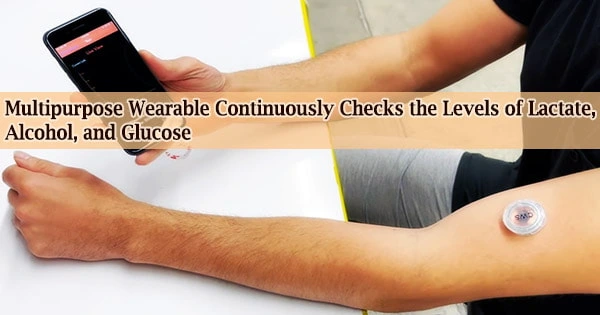Imagine having a little device that you can wear on your skin that can track your muscle tiredness during an exercise, check your blood sugar levels, and determine whether you’ve had too much to drink.
A prototype of such a wearable that can constantly monitor multiple health metrics, including glucose, alcohol, and lactate levels simultaneously in real-time, has been created by engineers at the University of California, San Diego.
The item resembles a stack of six quarters in size. It is applied to the skin using a microneedle patch that resembles Velcro and has minuscule needles roughly one-fifth the width of a human hair apiece.
The gadget is comfortable to use since the microneedles barely pierce the skin’s top layer in order to detect biomolecules in interstitial fluid, the fluid that surrounds the cells beneath the skin. The wearable device transmits data wirelessly to a specific smartphone app.
In a report published on May 9, 2022, in Nature Biomedical Engineering, researchers from the UC San Diego Center for Wearable Sensors describe their wearable sensor technology.
“This is like a complete lab on the skin,” said center director Joseph Wang, a professor of nanoengineering at UC San Diego and co-corresponding author of the paper. “It is capable of continuously measuring multiple biomarkers at the same time, allowing users to monitor their health and wellness as they perform their daily activities.”
Most commercial health monitors just assess one signal, like continuous glucose monitors for diabetic patients. The issue with that, according to the researchers, is that it omits information that, for instance, could assist people with diabetes more successfully control their disease.
Because drinking alcohol might cause glucose levels to drop, it is useful to monitor alcohol levels. People with diabetes can avoid having too low blood sugar levels after drinking by being aware of both levels.
Combining data on lactate is also beneficial because physical activity affects the body’s capacity to control glucose. Lactate can be measured during exercise as a biomarker for muscle fatigue.
This is like a complete lab on the skin. It is capable of continuously measuring multiple biomarkers at the same time, allowing users to monitor their health and wellness as they perform their daily activities.
Professor Joseph Wang
“With our wearable, people can see the interplay between their glucose spikes or dips with their diet, exercise, and drinking of alcoholic beverages. That could add to their quality of life as well,” said Farshad Tehrani, a nanoengineering Ph.D. student in Wang’s lab and one of the co-first authors of the study.
Microneedles merged with electronics
A microneedle patch and an electronics casing make up the wearable. In interstitial fluid, several enzymes on the tips of the microneedles interact with glucose, alcohol, and lactate. Small electric currents produced by these reactions are evaluated using electrical sensors and wirelessly transmitted to an app that the researchers created.
On a smartphone, the results are shown in real-time. Microneedles have the benefit of taking a direct sample of the interstitial fluid, and studies have shown that the biochemical levels found there closely match those found in the blood.
“We’re starting at a really good place with this technology in terms of clinical validity and relevance,” said Patrick Mercier, a professor of electrical and computer engineering at UC San Diego and co-corresponding author of the paper. “That lowers the barriers to clinical translation.”
The disposable microneedle patch can be removed from the electronic enclosure and changed with ease. The battery, wireless transmitter, electronic sensors, and other electronic parts are all housed in the reusable electronic case. Any wireless charging station for smartphones and smartwatches can be used to recharge the device.
One of the main hurdles the team faced was combining all these parts into a single compact, wireless wearable. Combining the microneedle patch, which is exposed to biological fluid, with the reusable electronics, which must remain dry, requires some innovative design and engineering.
“The beauty of this is that it is a fully integrated system that someone can wear without being tethered to benchtop equipment,” said Mercier, who is also the co-director of the UC San Diego Center for Wearable Sensors.
Testing
Five volunteers who wore the wearable on their upper arms while exercising, eating and drinking were included in the testing. The device was utilized to continuously check the subjects’ lactate or alcohol levels as well as their glucose levels.
The device’s measurements of glucose, alcohol, and lactate closely matched those made by a commercial blood glucose monitor, the Breathalyzer, and laboratory tests that measured the blood’s lactate levels.
Next steps
In order to advance the technology towards commercialization, Farshad Tehrani and another co-first author Hazhir Teymourian, a former postdoctoral researcher in Wang’s group, launched a startup business called AquilX.
Testing and making improvements to the microneedle patch’s durability before replacement are the next phases. The idea of adding more sensors to the gadget to track patient medication levels and other health signals excites the company as well.





